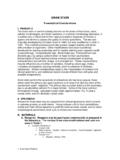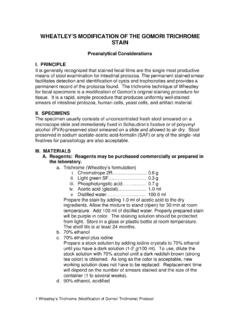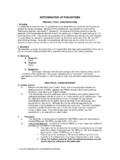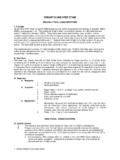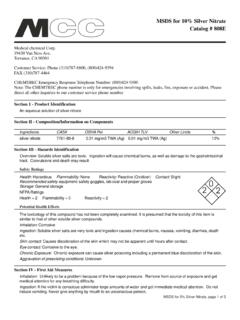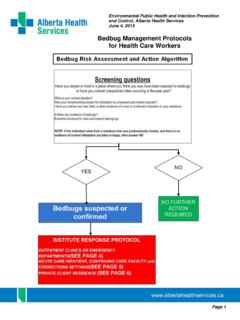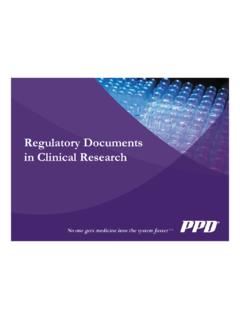Transcription of Giemsa Blood Stain Protocol - Med-Chem
1 1 Garcia ( Giemsa Stain ) Giemsa Stain PREANALYTICAL CONSIDERATIONS I. Principle Giemsa Stain is used to differentiate nuclear and/or cytoplasmic morphology of platelets, RBCs, WBCs, and parasites (1,2). The most dependable Stain for Blood parasites, particularly in thick films, is Giemsa Stain containing azure B. Liquid stock is available commercially. The Stain must be diluted for use with water buffered to pH or to , depending on the specific technique used. Either should be tested for proper staining reaction before use. The stock is stable for years, but it must be protected from moisture because the staining reaction is oxidative.
2 Therefore, the oxygen in water will initiate the reaction and ruin the stock Stain . The aqueous working dilution of Stain is good only for 1 day. II. Specimen The specimen usually consists of fresh whole Blood collected by finger puncture or of whole Blood containing EDTA ( g/10 ml of Blood ) that was collected by venipuncture and is less than 1 h old. Heparin (2 mg/10 ml of Blood ) or sodium citrate ( g/10 ml of Blood ) may be used as an anticoagulant if trypanosomes or microfilariae are suspected. If slides have been prepared, the specimen may be a thin Blood film that has been fixed in absolute methanol and allowed to dry, a thick Blood film that has been allowed to dry thoroughly and is not fixed, or a combination of a fixed thin film and an adequately dried thick film (not fixed).
3 The combination thick/thin Blood film is also acceptable. III. Materials A. Reagents 1. Giemsa Stain 2. Giemsa buffer B. Supplies 1. Glass slides (1 by 3 in., or larger if you prefer), alcohol washed 2. Glass marker 3. Blood collection supplies (if applicable) 4. Paper with newsprint-size print 5. Applicator sticks C. Equipment 1. Microscope, binocular with mechanical stage; low (10x), high dry (40x), and oil immersion (100x) objectives; 10x oculars; calibrated ocular micrometer; light source equivalent to 20-W halogen or 100-W tungsten bulb; blue and while ground-glass diffuser filters 2.
4 Timer, 1 h or more in 1-min increments ANALYTICAL CONSIDERATIONS IV. Quality Control A. The stock buffer solutions and buffered water should be clear, with no visible contamination. B. Check the Giemsa Stain reagents, including the pH of the buffered water, before each use. C. Prepare and Stain films from normal Blood , and microscopically evaluate the staining reactions of the RBCs, platelets, and WBCs; this assessment can also be accomplished by the examination of your patient slide. If the staining reactions are acceptable, then the QC is considered acceptable. a. Macroscopically, Blood films appear purplish.
5 If blue, the buffered water was too alkaline; if pink to red, the buffered water was too acid. b. Microscopically, RBCs appear pinkish gray, platelets appear deep pink, and WBCs have purple-blue nuclei and lighter cytoplasm. Eosinophilic granules are bright purple-red, and neutrophilic granules are purple. Basophilic stippling within uninfected RBCs is blue. c. Slight variation may appear in the colors described above depending on the batch of Stain used and the character of the Blood itself, but if the various morphological structures are distinct, the Stain is satisfactory. 2 Garcia ( Giemsa Stain ) D.
6 Although there is not universal agreement, the microscope should probably be recalibrated once each year. This recommendation should be considered with heavy use or if the microscope has been bumped or moved multiple times. If the microscope does not receive heavy use, then recalibration is not required on a yearly basis. E. Record all QC results. V. Procedure A. Wear gloves when performing this procedure. B. Thin Blood films (only) 1. Fix air-dried film in absolute methanol by dipping the film briefly (two dips) in a Coplin jar containing absolute methanol. 2. Remove and let air dry. 3.
7 Stain with diluted Giemsa Stain (1:20, vol/vol) for 20 min. For a 1:20 dilution, add 2 ml of stock Giemsa to 40 ml of buffered water in a Coplin jar. 4. Wash by briefly dipping the slide in and out of a Coplin jar of buffered water (one or two dips). Note: Excessive washing will decolorize the film. 5. Let air dry in a vertical position. C. Thick Blood films (only) 1. Allow film to air dry thoroughly for several hours or overnight. Do not dry films in an incubator or by heat, because this will fix the Blood and interfere with the lysing of the RBCs. Note: If a rapid diagnosis of malaria is needed, thick films can be made slightly thinner than usual, allowed to dry for 1 h, and then stained.
8 2. DO NOT FIX. 3. Stain with diluted Giemsa Stain (1:50, vol/vol) for 50 min. For a 1:50 dilution, add 1 ml of stock Giemsa to 50 ml of buffered water in a Coplin jar. 4. Wash by placing film in buffered water for 3 to 5 min. 5. Let air dry in a vertical position. D. Thin and thick Blood films on the same slide 1. Allow the thick film to air dry thoroughly 2. Fix air-dried film in absolute methanol by dipping the film briefly (two dips) in a Coplin jar containing absolute methanol. Be sure not to get the alcohol or its fumes on the thick film by slightly tilting the slide. 3. Remove and let air dry with the thick film up.
9 Be sure slide is thoroughly dry before staining. Introducing even a minute amount of methyl alcohol into the Stain dilution will interfere with the lysing of the RBCs in the thick films. 4. Stain the entire slide with diluted Giemsa Stain (1:50, vol/vol) for 50 min. For a 1:50 dilution, add 2 ml of stock Giemsa to 40 ml of buffered water in a Coplin jar. Place the slide in the Stain , thick film down to prevent the debris caused by dehemoglobinization from falling onto the thin film. 5. Rinse the thin film by briefly dipping the film in and out of a Coplin jar of buffered water (one or two dips). Wash the thick film for 3 to 5 min.
10 Be sure that the thick film is immersed but do not allow the water to cover any part of the thin film. 6. Let air dry in a vertical position with the thick film down. E. Combination thin and thick Blood films on the same slide (see Protocol ) (Figure 1) 1. Place a clean 1- by 3-in. glass microscope slide on a horizontal surface. 2. Place a drop (30 to 40 l) of Blood onto one end of the slide about in. from the end 3. Using an applicator stick lying across the glass slide and keeping the applicator in contact with the Blood and glass, rotate (do not roll ) the stick in a circular motion while moving the stick down the glass slide to the opposite end.

